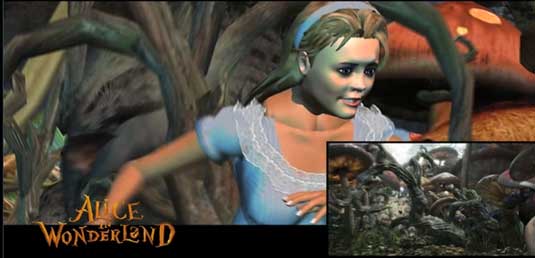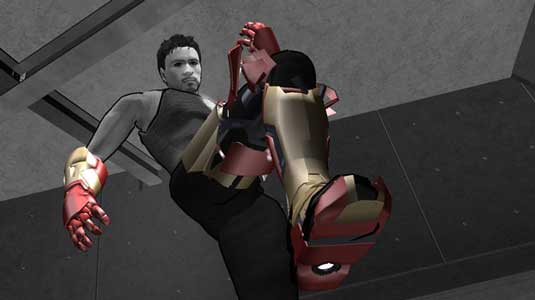The Third Floor on the secrets of previs

With studios in Los Angeles, Montreal and London, The Third Floor has worked on huge Hollywood movies such as Godzilla, Thor 2, Total Recall and Iron Man 3.
But even if you watched those movies, you probably won't have seen any of the work it's created - not exactly anyway. Because it's a company that's entirely geared towards previs.
Previs, for the uninitiated, is short for previsualization, the process of visualizing a project right at the start. Historically, filmmakers relied on storyboards, concept artwork and physical models to help them plan their visions. Modern previs teams complement and accelerate this process by using computer animation to represent filmmakers’ choices in motion.

Previsualization techniques are being used for everything from commercials to games to movies, and mean story ideas and cinematic choices can be tested and improved in iteration, until each sequence is approved to move on to production.
By delivering a clear blueprint, it can save producers countless hours on set and in post, reduce costs and ensure the highest quality results.
Not the easy option
But while there's not the same painstaking attention to detail as working on finished VFX, don't think previs is the easy option. Because as Duncan Burbidge - studio manager of The Third Floor's London office - explains, previs presents equally tough demands of its own. Not least of these is the need to work at incredible speed - which means artists have to control their natural instinct to aim for perfection.
"Where in a visual effects world or a finals world you might be given a few weeks to finish a shot, here they're averaging like a shot a day," he explains. "That gives you a great indication of how fast things go." This can take a while for new recruits to get their heads around, Burbidge adds. "I've worked with a lot of great animators in my time and they'll spend hours meticulously working over the fine details to get the best performance out of whatever they're animating. But here it's always about shortcuts - how can you convey a complex piece of information and as efficiently as possible?
Daily design news, reviews, how-tos and more, as picked by the editors.
"You need to ask yourself: how much animation is required; can you do motion capture instead of animation...? There's a whole range of stuff that the previs artists need to go through each day to try to quickly get out the shots."
Creative challenges
So there's no 'one size fits all' approach - each project has its own challenges. "On one show we've worked on, for example, we needed to get through a lot of material very quickly. So we had a team in London and we had a team in LA working almost 24 hours a day, five days a week doing a lot of previs in a very short space of time. That presented a whole range of challenges in terms of resourcing and keeping everybody in sync.

"But then other projects have creative challenges where the scripts keep changing or things are shifting around to such a degree. When that happens, we're constantly trying to keep up to date, keep things ahead. It really depends on the production and what the previs is being used for."
Long history
None of this fazes Burbidge himself, though, as he has a long history in previs. After studying film in Australia and moving to the UK, he worked as a previs coordinator on the Wachowskis' Matrix trilogy.
"The Matrix 2 and 3 - that was my first job," he smiles. "I had an interview on the Thursday and then on the Monday morning I was working with the Wachowskis. It was pretty insane."
He went on to coordinate previs and final VFX sequences on Terry Gilliam’s The Brothers Grimm, before joining Framestore in 2005, where he managed pre-production for features including Harry Brown and Triangle and served as VFX producer on such high-profile projects as Clash of the Titans and War Horse.
Early doors
In 2011, he decided he "needed a change away from visual effects" and joined The Third Floor London in its first days as senior producer.

"I was the first hire, basically," he explains. "I was setting up the office, doing all the hiring, setting up all the infrastructure, bidding and winning all the work, all the client management stuff as well. And then just devising a business plan going forward.
"It's kind of crazy, we didn't expect it to take off quite so quickly. I imagined it would be myself and around seven artists and that would be it. But instead it quickly grew to 20, and we're now nearly 40, and it's a different thing entirely."
Software
Software wise, the artists at The Third Floor mainly use Maya and Adobe suite, including After Effects, Photoshop and Premiere Pro. The Third Floor has its own internal pipeline but, Burbidge stresses, "it's not a hindrance to the artists. It's just there to support a few different tasks and speed that process up. We use off the shelf software so we can just get in and get started, get stuff out as fast as we can."

If that sounds like an environment that attracts you, then it's well worth checking out the company's recruitment pages. "We're always recruiting and taking on new artists and seeing how they get on," Burbidge enthuses. The kind of people they're looking for are those with: "good strong camerawork and composition, and who really understand that film grammar.
"It's not just about good animation skills," he stresses. "It's about how they're shooting, what's their coverage like, how are they cutting things together, is it cinematic, are they adhering to those cinematic conventions and so forth.
"The way we see it, artists generally are like little mini filmmakers in their own right, and that's how it should be."
Duncan Burbidge will be speaking at HP ZED Paris on Tuesday 8 April, 2014 (1900-2200), where he'll present some of the latest work of the company and outline the tools and processes used. The event is free to attend: you'll find details of how to sign up below.
Win a trip to Los Angeles!

Masters of CG is a competition for EU residents that offers the one-in-a-lifetime chance to work with one of 2000AD's most iconic characters: Rogue Trooper.
We invite you to form a team (of up to four participants) and tackle as many of our four categories as you wish - Title Sequence, Main Shots, Film Poster or Idents. For full details of how to enter and to get your Competition Information Pack, head to the Masters of CG website now.
Enter the competition today!

Tom May is an award-winning journalist specialising in art, design, photography and technology. His latest book, The 50 Greatest Designers (Arcturus Publishing), was published this June. He's also author of Great TED Talks: Creativity (Pavilion Books). Tom was previously editor of Professional Photography magazine, associate editor at Creative Bloq, and deputy editor at net magazine.
